An S-Band-Receiving Phased-Array Antenna with a Phase-Deviation-Minimized Calibration Method for LEO Satellite Ground Station Applications
Abstract
:1. Introduction
2. Structure of the Proposed Phased-Array Antenna
2.1. Antenna Subarrays
2.2. Beamforming Rx RF Modules (BF-RFMs)
3. Full Phased-Array Antenna System
3.1. Arrangements of the BF-RFMs
3.2. Assembly of the Phased-Array Antenna
4. Measurements and Calibration
5. Conclusions
Author Contributions
Funding
Data Availability Statement
Conflicts of Interest
References
- Haupt, R.L.; Rahmat-Samii, Y. Antenna array developments: A perspective on the past, present and future. IEEE Antennas Propag. Mag. 2015, 57, 86–96. [Google Scholar] [CrossRef]
- Hong, W.; Jiang, Z.H.; Yu, C.; Zhou, J.; Chen, P.; Yu, Z.; Zhang, H.; Yang, B.; Pang, X.; Jiang, M.; et al. Mutibeam antenna technologies for 5G wireless communications. IEEE Trans. Antennas Propag. 2017, 65, 6231–6249. [Google Scholar] [CrossRef]
- Chen, Z.N.; Qing, X.; Tang, X.; Liu, W.E.I.; Xu, R. Phased array metantennas for satellite communications. IEEE Commun. Mag. 2022, 60, 46–50. [Google Scholar] [CrossRef]
- Alolyania, M.Q.; Harb, K.M. Phased array antennas for satellite communications. In Proceedings of the 2021 IEEE 12th Control and System Graduate Research Colloquium (ICSGRC 2021), Shah Alam, Malaysia, 7 August 2021; pp. 150–153. [Google Scholar]
- Gopal, M.; Ray, K.P. Design of 16 × 16 phased array antenna for X-band radar. In Proceedings of the 3rd International Conference on Emerging Technology (INCET), Belgaum, India, 22–29 May 2022; pp. 1–6. [Google Scholar]
- Prasad, S.; Meenakshi, M.; Adhithiya, N.; Rao, P.H.; Ganti, R.K.; Bhaumik, S. mmWave multibeam phased array antenna for 5G applications. J. Electromagn. Waves Appl. 2021, 35, 1802–1814. [Google Scholar] [CrossRef]
- He, G.; Gao, X.; Sun, L.; Zhang, R. A review of multibeam phased array antennas as LEO satellite constellation ground station. IEEE Access 2021, 9, 147142–147154. [Google Scholar] [CrossRef]
- Chieh, J.-C.S.; Yeo, E.; Farkouh, R.; Castro, A.; Kerber, M.; Olsen, R.B.; Merulla, E.J.; Sharma, S.K. Development of flat panel active phased array antennas using 5G silicon RFICs at Ku- and Ka-bands. IEEE Access 2020, 8, 192669–192681. [Google Scholar] [CrossRef]
- Zaki, S.B.M.; Kaya, N.; Cho, M. Implementation of adaptive antenna array for ground station tracking system. Transcations Jpn. Soc. Aeronaut. Space Sci. Aerosp. Technol. Jpn. 2020, 18, 199–208. [Google Scholar]
- McHugh, B. Strengthen SATCOM with SDR-Enhanced Phased Array Antennas. Microwaves&RF, 23 September 2022. Available online: https://www.mwrf.com (accessed on 8 November 2022).
- Boulos, F.; Caizzone, S.; Winterstein, A. A subarray-based antenna design for satellite communications ground terminals in Ka-band. In Proceedings of the 26th Ka and Broadband Communications Conference, Arlington, VA, USA, 27–30 September 2021. [Google Scholar]
- Drioli, L.S.; Foged, L.J.; Saccardi, F.; Scialacqua, L. Verification of Complex Excitation Coefficients from Measured Space Array Antenna by Equivalent Current Techniques. 2014. Available online: www.mvg-world.com (accessed on 14 September 2022).
- Jung, D.; Kim, J. Method to determine the far-field beam pattern of a long array from subarray beam pattern. Sensors 2020, 20, 1236. [Google Scholar] [CrossRef] [PubMed] [Green Version]
- Javed, M.Y.; Tervo, N.; Leinonen, M.E.; Pärssinen, A. Sidelobe reduction by subarray stacking for uniformly exited mmW phased arrays. In Proceedings of the IEEE 30th Annual International Symposium on Personal, Indoor and Mobile Radio Communications (PIMRC), Istanbul, Turkey, 8–11 September 2019. [Google Scholar]
- Bräutigam, B.; Schwerdt, M.; Bachmann, M. An efficient method for performance monitoring of active phase array antenna. IEEE Trans. Geosci. Remote Sens. 2009, 47, 1236. [Google Scholar] [CrossRef] [Green Version]
- Nauyen, V.-V.; Nam, H.; Choe, Y.J.; Lee, B.-H.; Park, J.-D. An X-band bi-directional transmit/receive module for a phased array system in 65-nm CMOS. Sensors 2018, 18, 2569. [Google Scholar] [CrossRef] [PubMed] [Green Version]
- Kopecký, P.; Závidný, V. Measurement of far-field patterns of phased array antenna. In Proceedings of the 2015 Conference on Microwave Techniques, Pardubice, Czech Republic, 22–23 April 2015. [Google Scholar]
- Hassett, K. Phased array antenna calibration measurement techniques and methods. In Proceedings of the European Conference on Antennas Propagation (EuCAP), Davos, Switzerland, 10–15 April 2016. [Google Scholar]
- Haryu, K.; Chiba, I.; Mano, S.; Katagi, T. Near field measurement method of a phased array antenna measurement of element amplitude and phase for array. IEICE Trans. Commun. Jpn. Ed. 1196, 79, 97–105. [Google Scholar] [CrossRef]
- Burla, M.; Roeloffzen, C.G.H.; Zhung, L.; Marpaung, D.; Khan, M.R.; Maat, P.; Dijkstra, K.; Leinse, A.; Hoekman, M.; Heideman, R. System integration and radiation measurements of a phased array antenna employing an integrated photonic beamformer for radio astronomy applications. Appl. Opt. 2012, 51, 789–802. [Google Scholar] [CrossRef] [PubMed]
- Adithya, A.H.; Huang, Y.; Weber, R.J. Experimental evaluation of a beamforming array calibration system. In Proceedings of the 2014 IEEE Aerospace Conference, Big Sky, MT, USA, 1–8 March 2014. [Google Scholar]
- Mano, S.; Katagi, T. A method for measuring amplitude and phase of each radiating element of a phased array antenna. Trans. IECE 1982, 65, 58–64. [Google Scholar] [CrossRef]
- Takahashi, T.; Miyashita, H.; Konishi, Y.; Makino, S. Theoretical study on measurement accuracy of rotating element electric field vector (REV) method. Electron. Commun. Jpn. 2006, 90, 22–33. [Google Scholar] [CrossRef]
- Takahashi, T.; Konishi, Y.; Makinom, S.; Ohmine, H.; Nakaguro, H. Fast measurement technique for phased array calibration. IEEE Trans. Antennas Propag. 2008, 56, 1888–1899. [Google Scholar] [CrossRef]
- Yonezawa, R.; Konishi, Y.; Chiba, I.; Katagi, T. Beam-shape correction in deployable phased arrays. IEEE Trans. Antennas Propag. 1999, 47, 482–486. [Google Scholar] [CrossRef]
- Hu, C.N. A novel method for calibrating deployed active antenna arrays. IEEE Trans. Antennas and Propag. 2015, 63, 1650–1657. [Google Scholar] [CrossRef]
- Pozar, D.M. Microwave Engineering, 4th ed.; John Wiley & Sons: New York, NY, USA, 2012; Chapter 4. [Google Scholar]
- Stutzman, W.L.; Thiele, G.A. Antenna Theory and Design, 3rd ed.; John Wiley & Sons: New York, NY, USA, 2013; Chapter 8. [Google Scholar]


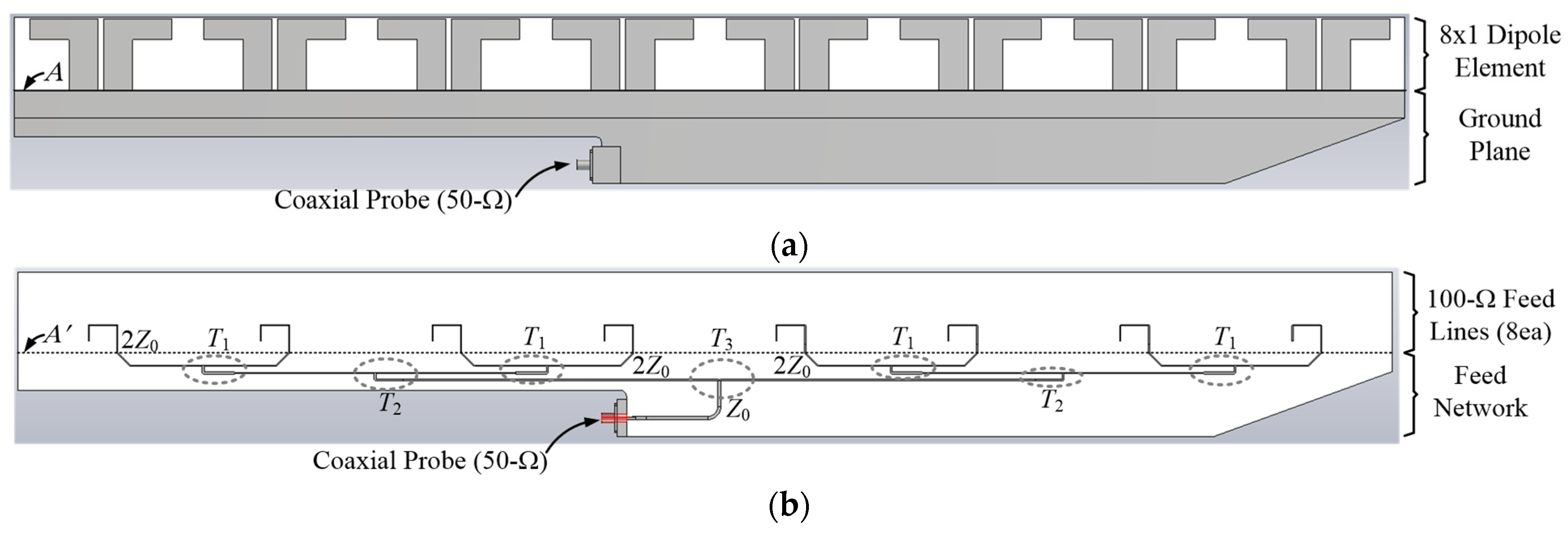
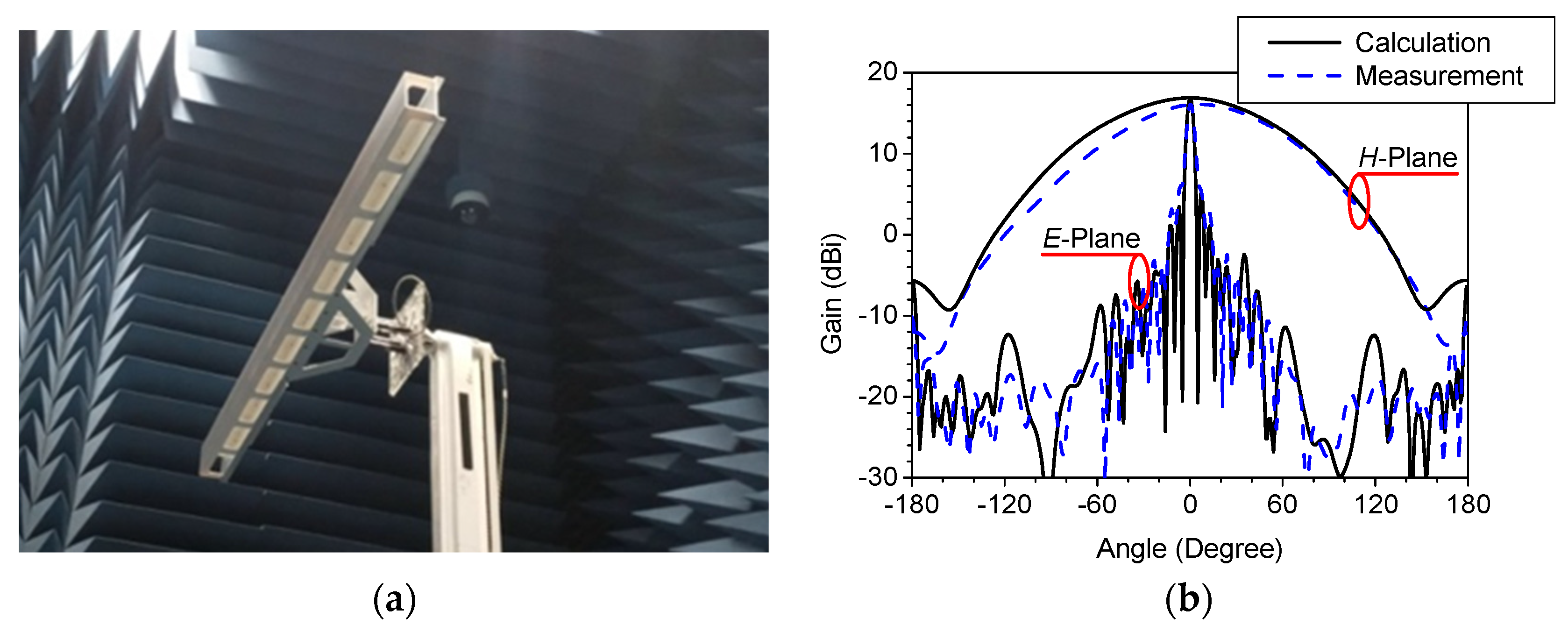
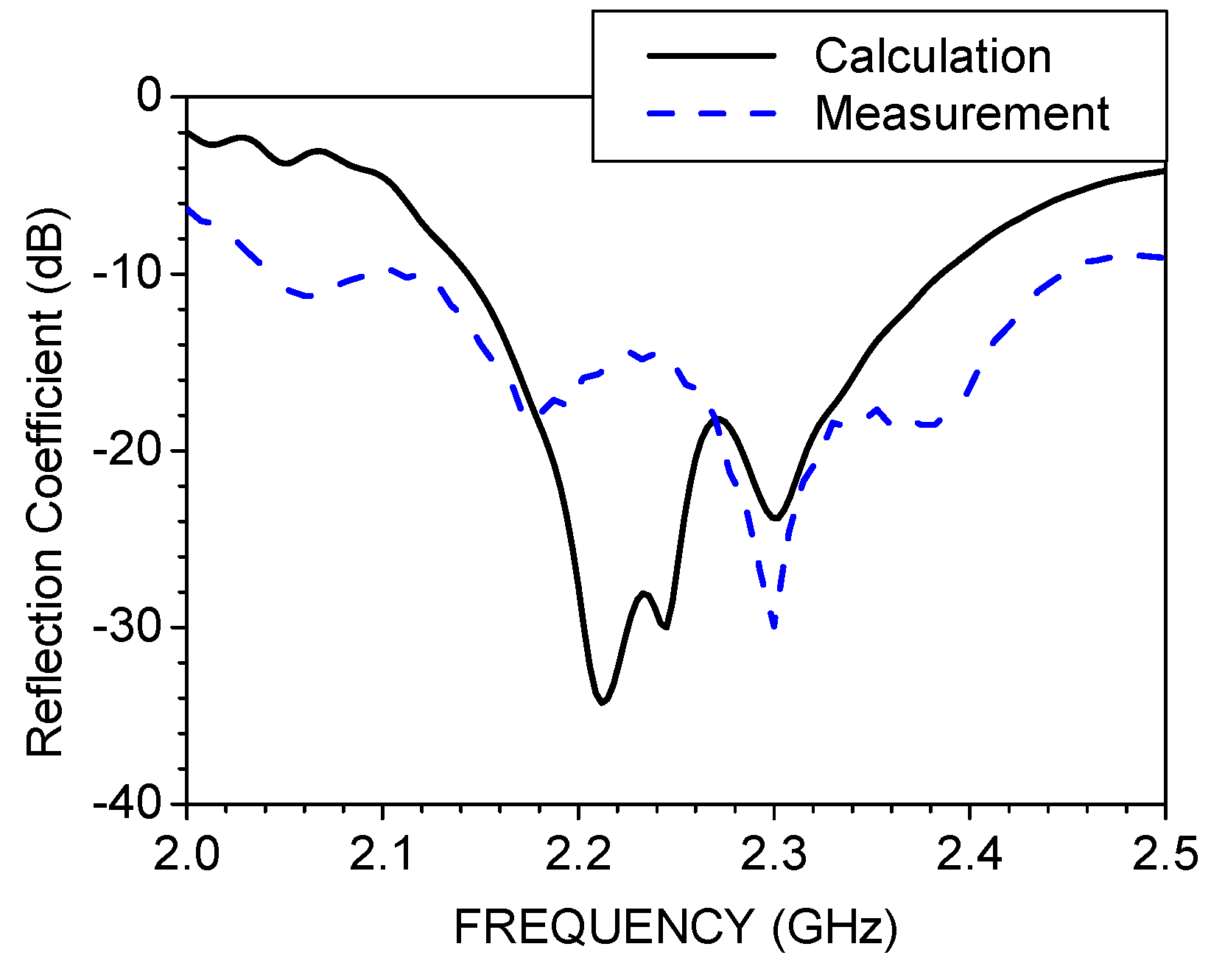

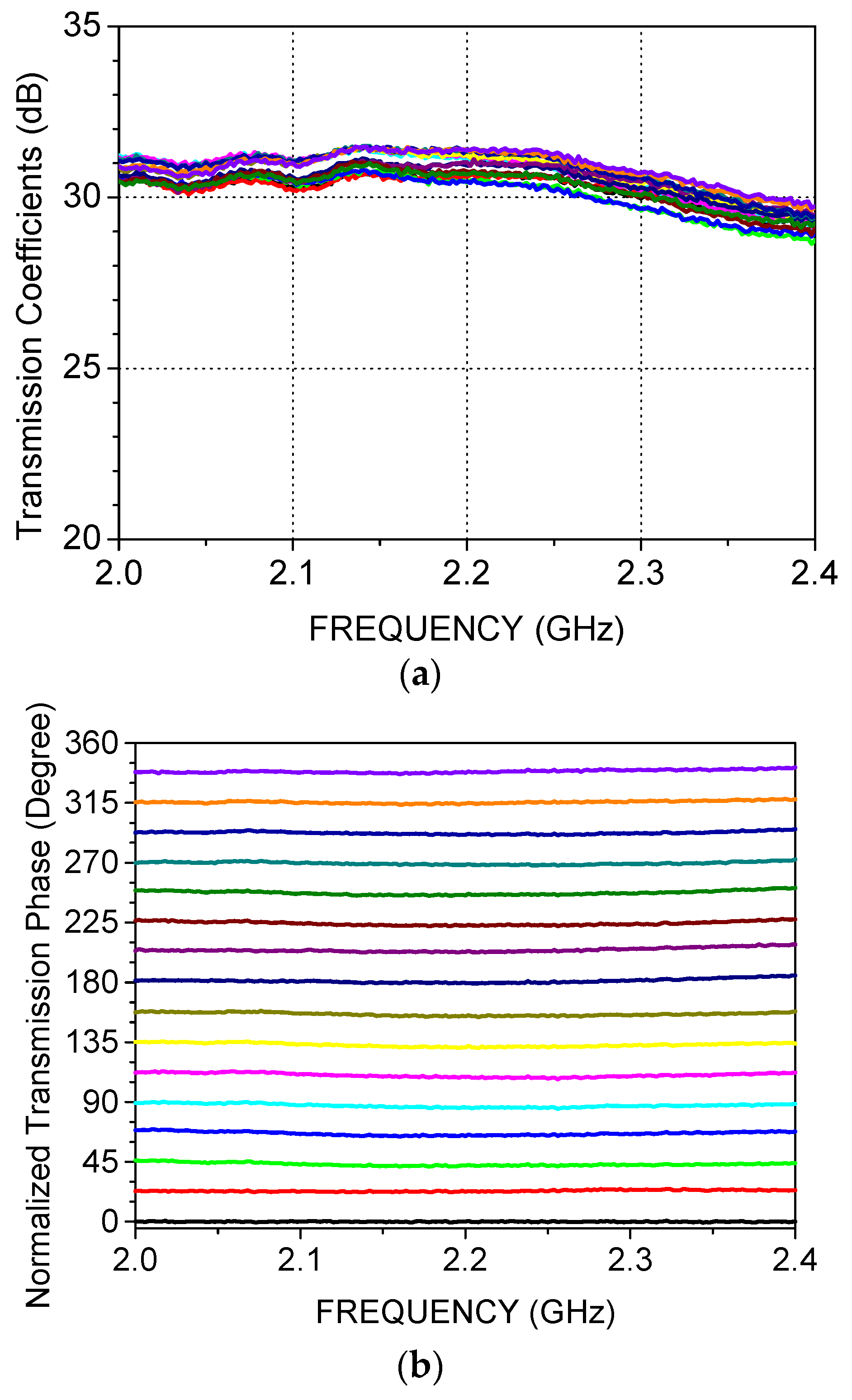
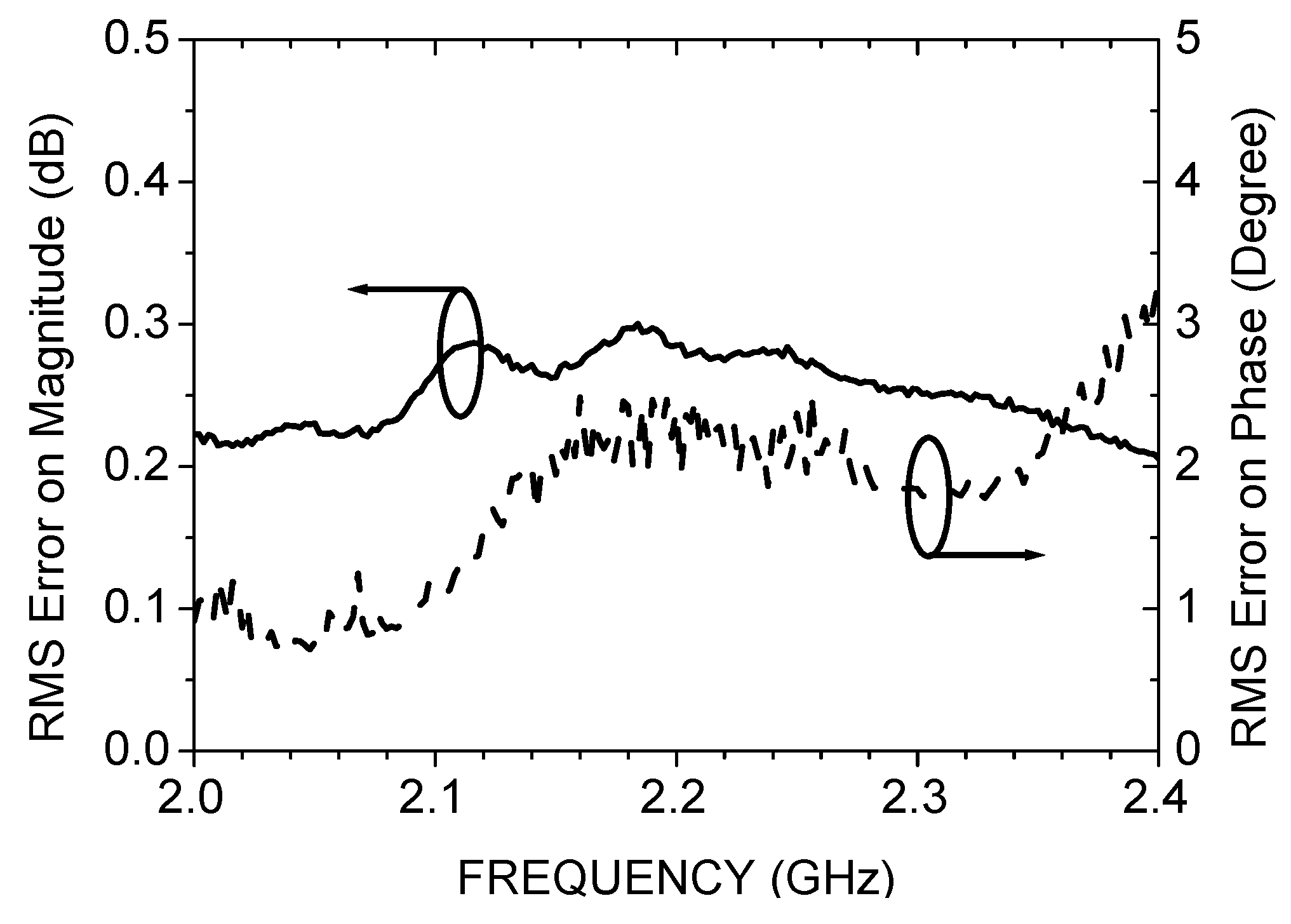
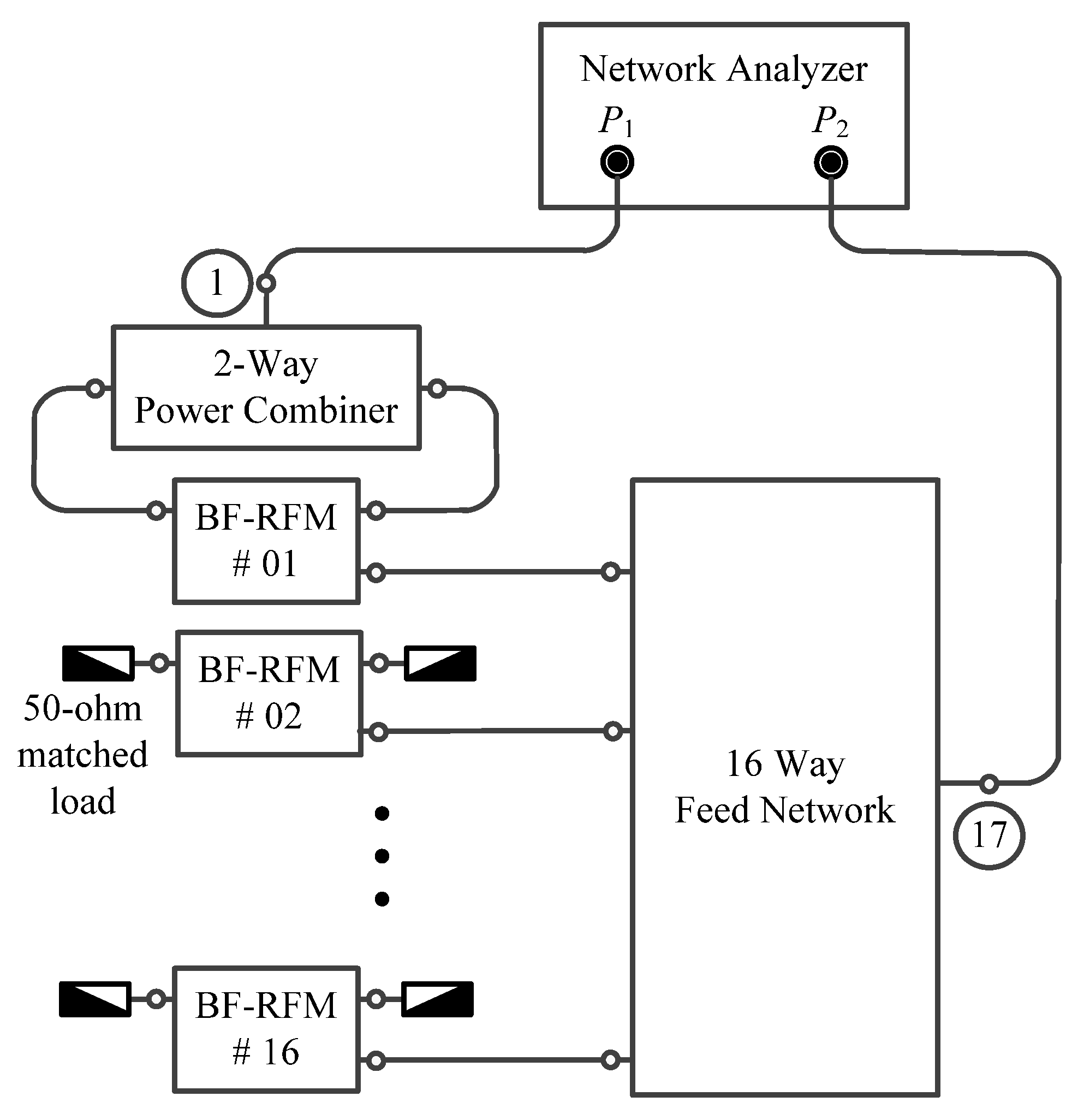

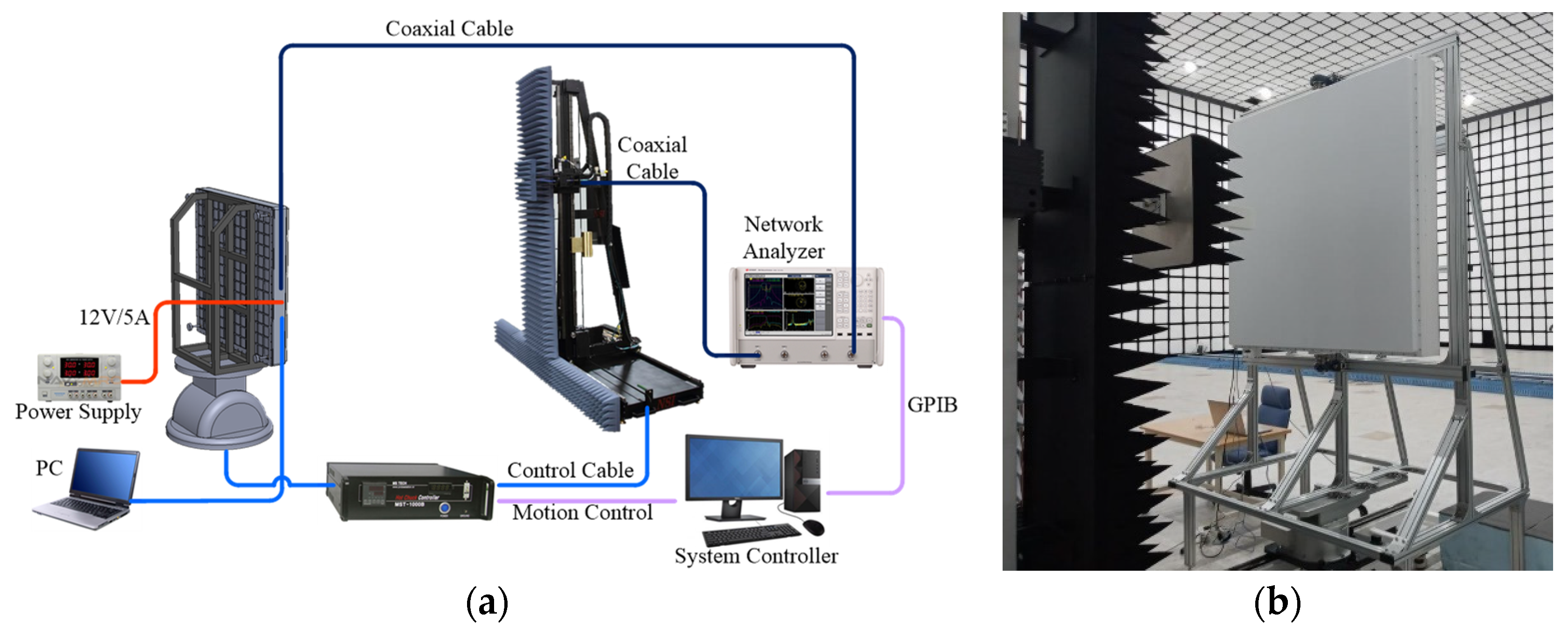
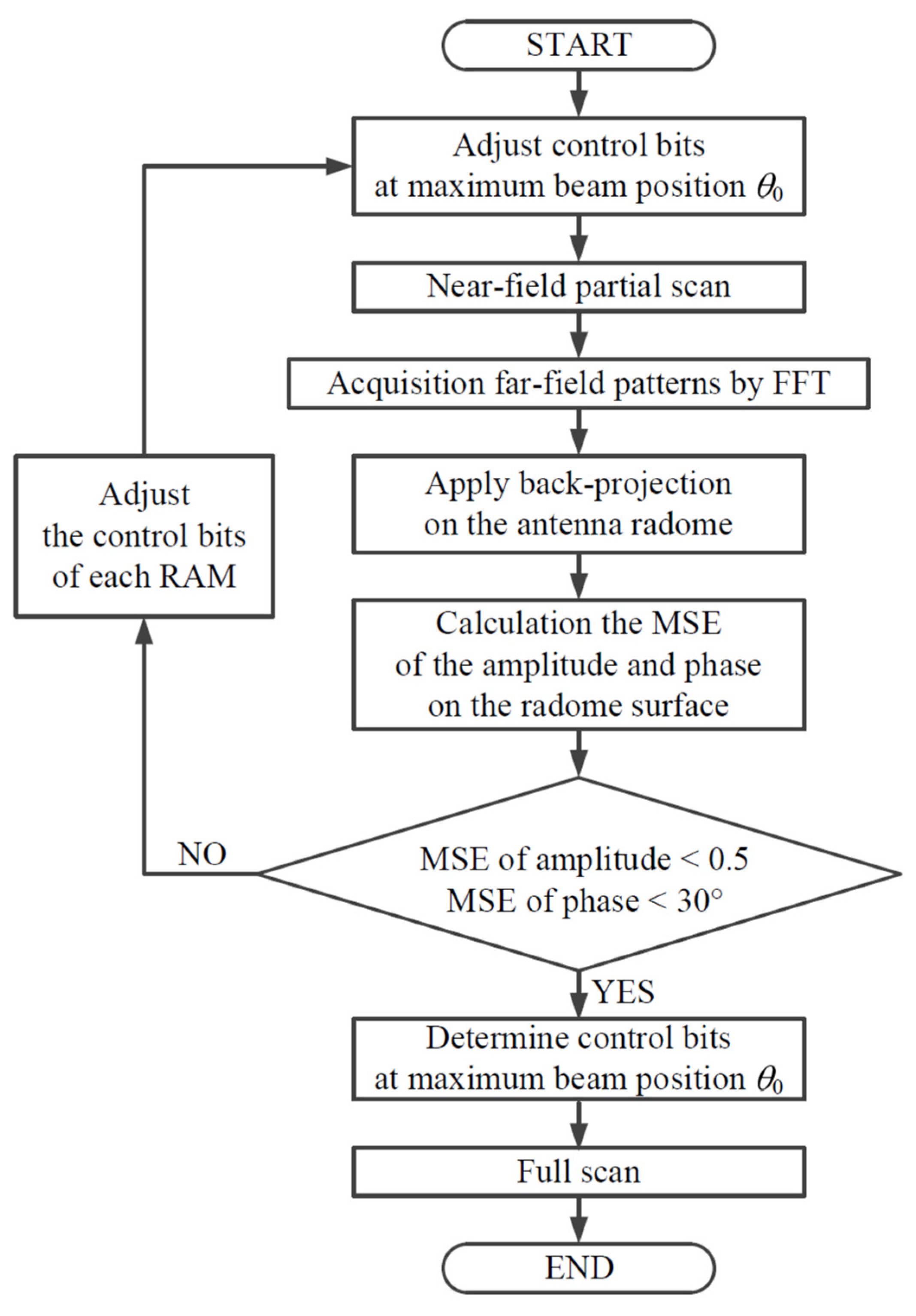
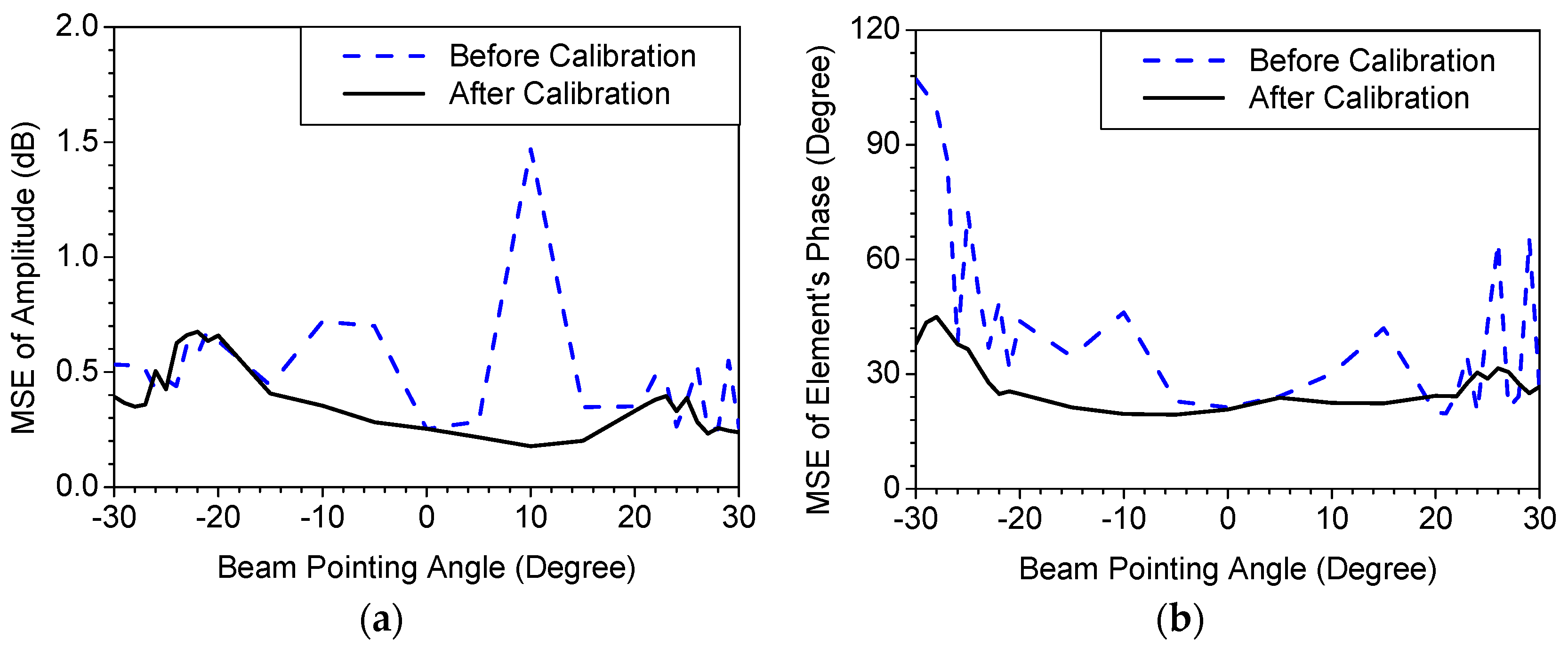
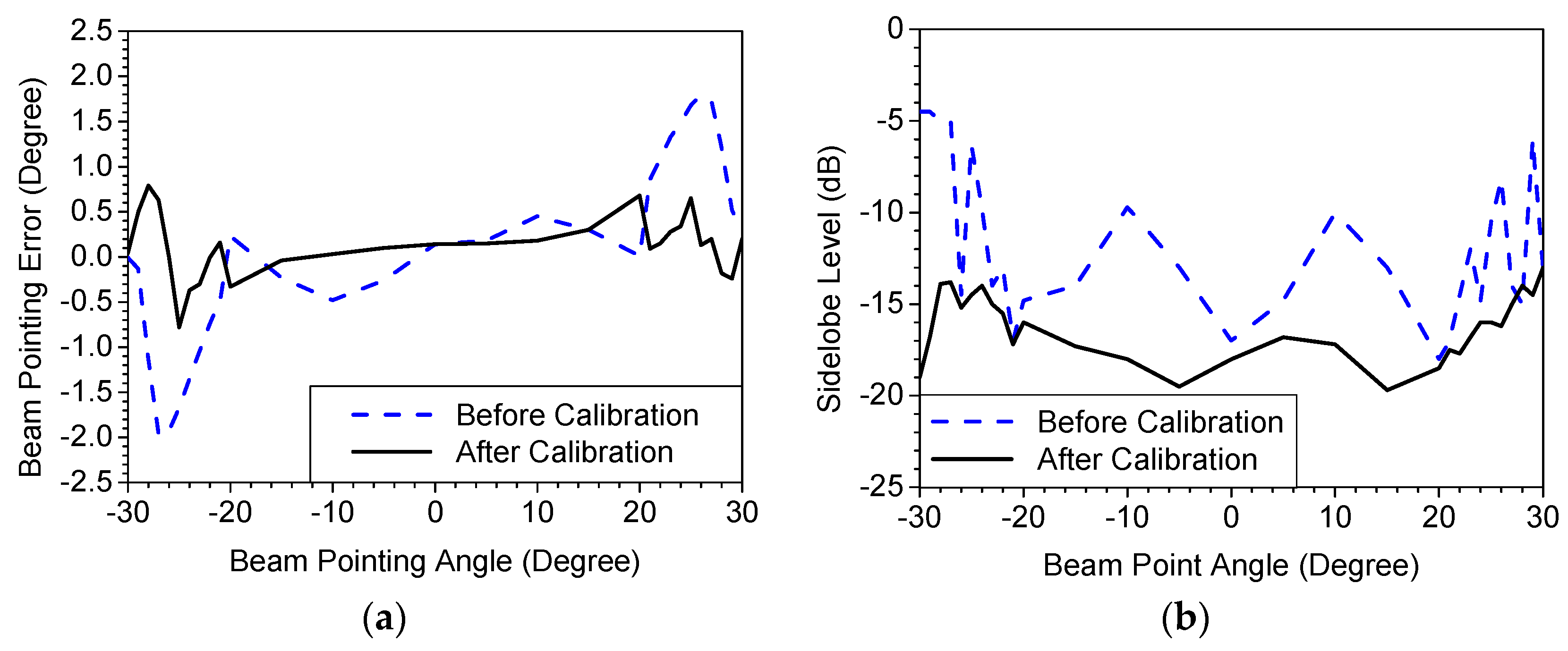
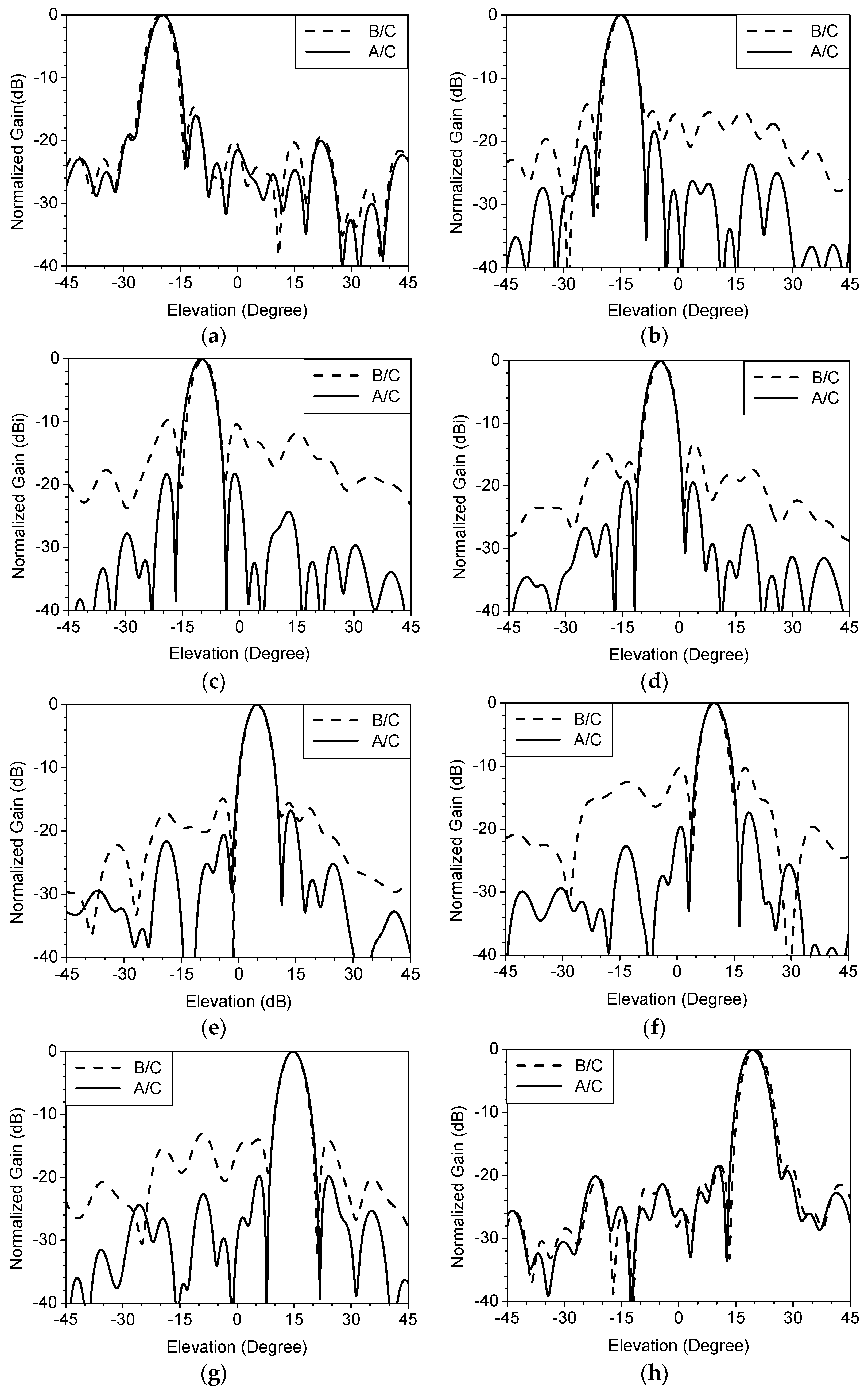
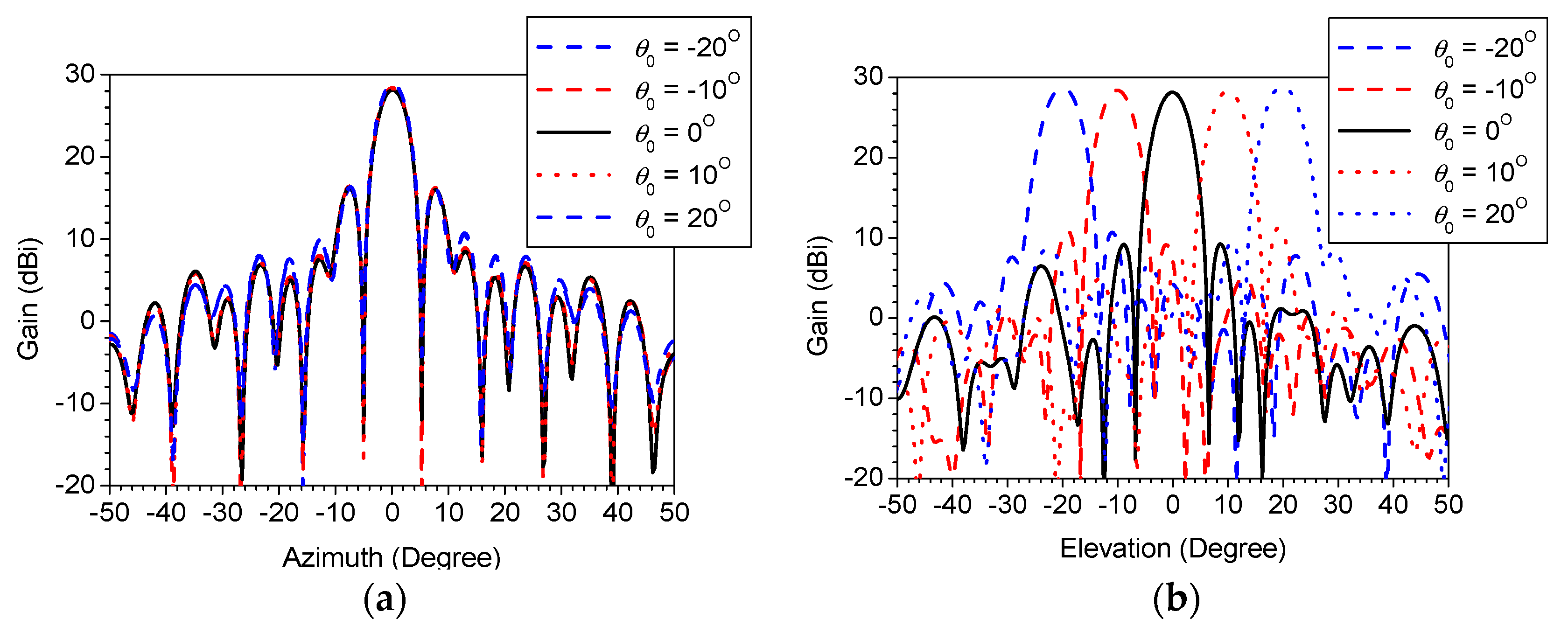
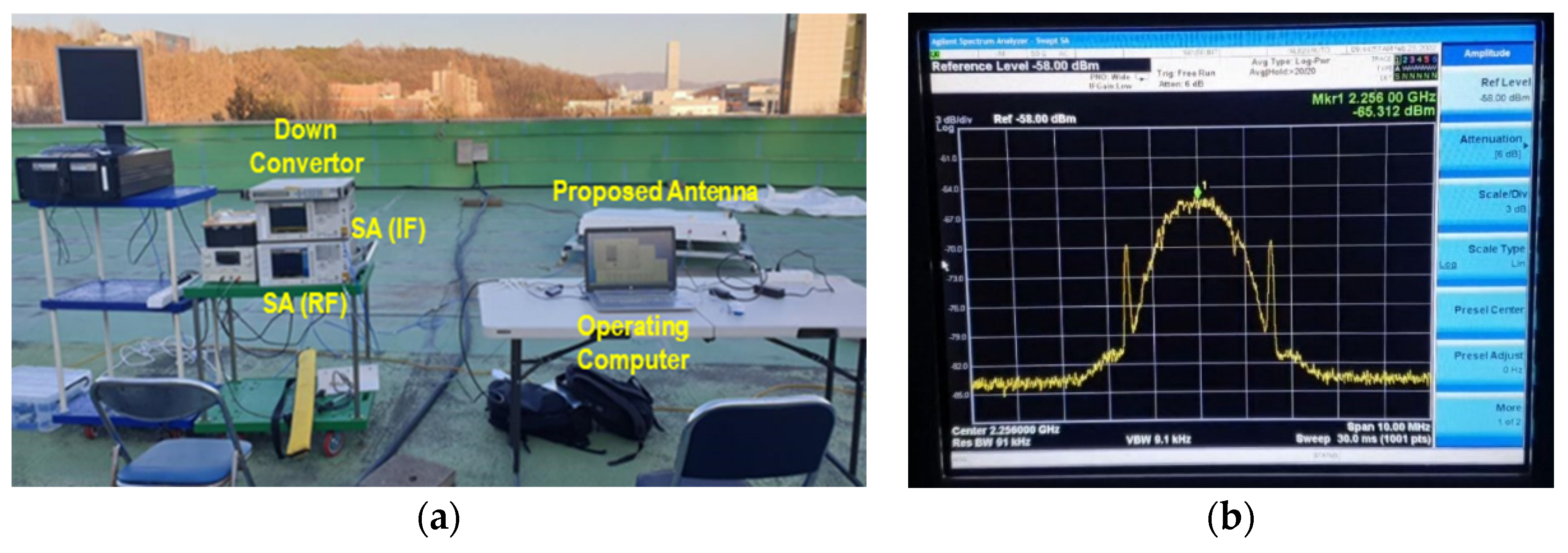
| Reference | Calibration Method | Measurement Equipment | Measuring Time | Array Size in Measurement |
|---|---|---|---|---|
| Harya [19] | REV method | Near-field | Long | 29 Elements |
| Adithya [21] | Adjusting weighting function at individual beamformers | Far-field | Long | 8 Elements |
| Yonezawa [25] | REV method + adjusting the observation position | Near-field | Long | 8 Elements |
| Hu [26] | Self-calibration system with the phase-match method | Far-field | Medium | 8 Elements |
| This work | Analysis of the back-projected field with the partial scan | Near-field | Short | 16 Elements |
Publisher’s Note: MDPI stays neutral with regard to jurisdictional claims in published maps and institutional affiliations. |
© 2022 by the authors. Licensee MDPI, Basel, Switzerland. This article is an open access article distributed under the terms and conditions of the Creative Commons Attribution (CC BY) license (https://creativecommons.org/licenses/by/4.0/).
Share and Cite
Lee, D.-H.; Seo, J.-W.; Lee, M.-S.; Chung, D.; Lee, D.; Bang, J.-H.; Satriyotomo, B.; Pyo, S. An S-Band-Receiving Phased-Array Antenna with a Phase-Deviation-Minimized Calibration Method for LEO Satellite Ground Station Applications. Electronics 2022, 11, 3847. https://doi.org/10.3390/electronics11233847
Lee D-H, Seo J-W, Lee M-S, Chung D, Lee D, Bang J-H, Satriyotomo B, Pyo S. An S-Band-Receiving Phased-Array Antenna with a Phase-Deviation-Minimized Calibration Method for LEO Satellite Ground Station Applications. Electronics. 2022; 11(23):3847. https://doi.org/10.3390/electronics11233847
Chicago/Turabian StyleLee, Dong-Hyo, Jung-Won Seo, Myeong-Shin Lee, Daewon Chung, Dongkook Lee, Jae-Hoon Bang, Bagas Satriyotomo, and Seongmin Pyo. 2022. "An S-Band-Receiving Phased-Array Antenna with a Phase-Deviation-Minimized Calibration Method for LEO Satellite Ground Station Applications" Electronics 11, no. 23: 3847. https://doi.org/10.3390/electronics11233847





